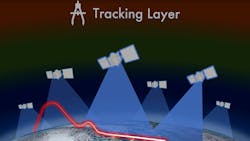SDA Awards Contracts for First-Generation Tracking Layer
The Space Development Agency (SDA) announced two contract awards for the first generation of the tracking layer, awards that will contribute to the creation of an extensive defense environment that will protect against space-based threats. The SDA orchestrates U.S. military advantage in space for national defense; for example, providing a defense against actions by threat nations that could potentially destroy U.S. satellites. The tracking layer will be a heterogeneous constellation of wide field of view (WFOV) space vehicles (SVs) that provide global defensive coverage and work with the Missile Defense Agency (MDA) Hypersonic and Ballistic Tracking Space Sensor (HBTSS) Medium Field of View (MFOV) SVs for global coverage. The contract awards were made to Space Exploration Technologies Corp. and L3 Harris Technologies.
SpaceX received a $149 million firm-fixed-price contract for on-time delivery of space vehicles and WFOV payloads. Work will be performed at various locations in the continental U. S. as part of the development of the WFOV capabilities of the tranche 0 or initial portion of the SDA tracking layer. Funds were designated from fiscal 2020 defense-wide research, development, test, and evaluation funds. L3 Harris Technologies received a $193.6 million firm-fixed-price contract for tracking layer tranche 0 WFOV coverage. Work in space involves building a comprehensive military advantage and integrating SDA’s space-based efforts with terrestrial allies and partners while also streamlining operations with such organizations as NASA and the Federal Aviation Administration (FAA).
The first set of contract awards finances the development of the first eight proliferated WFOV SVs. These SVs operating within tracking layer tranche 0 will provide missile-warning and tracking capabilities to national defense authorities. The SVs will also provide whatever tracking and cueing data needed for effective missile defense actions.
About the Author
Jack Browne
Technical Contributor
Jack Browne, Technical Contributor, has worked in technical publishing for over 30 years. He managed the content and production of three technical journals while at the American Institute of Physics, including Medical Physics and the Journal of Vacuum Science & Technology. He has been a Publisher and Editor for Penton Media, started the firm’s Wireless Symposium & Exhibition trade show in 1993, and currently serves as Technical Contributor for that company's Microwaves & RF magazine. Browne, who holds a BS in Mathematics from City College of New York and BA degrees in English and Philosophy from Fordham University, is a member of the IEEE.
